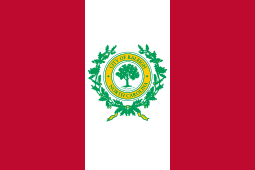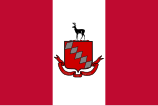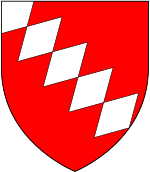
An oak is a hardwood tree or shrub in the genus Quercus of the beech family. They have spirally arranged leaves, often with lobed edges, and a nut called an acorn, borne in a cup. The genus is widely distributed in the Northern Hemisphere; it includes some 500 species, both deciduous and evergreen. Fossil oaks date back to the Middle Eocene. Molecular phylogeny shows that the genus is divided into Old World and New World clades, but many oak species hybridise freely, making the genus's history difficult to resolve.

USS Winston S. Churchill (DDG-81) is an Arleigh Burke-class destroyer of the United States Navy. She is named after Sir Winston Churchill, former Prime Minister of the United Kingdom. This ship is the 31st destroyer of her class. Winston S. Churchill was the 18th ship of this class to be built at Bath Iron Works in Bath, Maine, and construction began on 7 May 1998. She was launched and christened on 17 April 1999. On 10 March 2001, she was commissioned during a ceremony at Town Point Park in Norfolk, Virginia.

Quercus alba, the white oak, is one of the preeminent hardwoods of eastern and central North America. It is a long-lived oak, native to eastern and central North America and found from Minnesota, Ontario, Quebec, and southern Maine south as far as northern Florida and eastern Texas. Specimens have been documented to be over 450 years old.

The national flag of Romania is a tricolour. The Constitution of Romania states that "The flag of Romania is tricolour; the colours are arranged vertically in the following order from the flagpole: blue, yellow, red". The flag has a width-length ratio of 2:3; the proportions, shades of colour as well as the flag protocol were established by law in 1994, and extended in 2001.

The national flag of Ecuador, which consists of horizontal bands of yellow, blue and red, was first adopted by law in 1835 and later on 26 September 1860. The design of the current flag was finalized in 1900 with the addition of the coat of arms in the center of the flag. Before using the yellow, blue and red tricolor, Ecuador's former flag had three light blue stripes and two white stripes with three white stars for each province of the country.The design of the flag is very similar to those of Colombia and Venezuela, which are also former constituent territories of Gran Colombia. All three are based on a proposal by Venezuelan General Francisco de Miranda, which was adopted by Venezuela in 1811 and later Gran Colombia with some modifications. There is a variant of the flag that does not contain the coat of arms that is used by the merchant marine. This flag matches Colombia's in every aspect, but Colombia uses a different design when her merchant marine ships are at sail.

The flag of El Salvador features a horizontal triband of cobalt blue-white-cobalt blue, with the coat of arms centered and entirely contained within the central white stripe. This design of a triband of blue-white-blue is commonly used among Central American countries. El Salvador's flag is one of few that currently use the color purple, due to the rainbow in its coat of arms.

The flag of Peru was adopted by the government of Peru in 1825, and modified in 1950. According to the article 49 of the Constitution of Peru, it is a vertical triband with red outer bands and a single white middle band. Depending on its use, it may be defaced with different emblems, and has different names. Flag day in Peru is celebrated on 7 June, the anniversary of the Battle of Arica.

USS Raleigh (C-8) was a United States Navy protected cruiser of the Cincinnati class, commissioned in 1894 and in periodic service until 1919.

USS Chafee (DDG-90) is an Arleigh Burke-class guided missile destroyer in United States Navy. She is named for Senator John Lester Hubbard Chafee (1922–1999), a Marine veteran of Guadalcanal who also served as the Secretary of the Navy. Chafee was laid down by the Bath Iron Works in Bath, Maine on 12 April 2001, launched on 2 November 2002 and commissioned on 18 October 2003 in Newport, Rhode Island, the home state of the ship's namesake.

USS McCampbell (DDG-85) is an Arleigh Burke-class destroyer in the United States Navy. She is named in honor of Naval Aviator Captain David S. McCampbell, a Medal of Honor and Navy Cross recipient who was the Navy's leading ace in World War II. This ship is the 35th destroyer of her class. USS McCampbell was the 20th ship of this class to be built by Bath Iron Works at Bath, Maine, and construction began on 16 July 1999. She was launched and christened on 2 July 2000. On 17 August 2002, the commissioning ceremony was held at Pier 30 in San Francisco, California.

USS Carter Hall (LSD-50) is a Harpers Ferry-class dock landing ship of the United States Navy. She is the second US Navy ship to be named for Carter Hall, an estate near Winchester, Virginia, built in the 1790s.

The city flag of Los Angeles consists of a background of three notched stripes of green, gold and red. The flag was designed by Roy E. Silent and E.S. Jones in 1931 for the Los Angeles sesquicentennial from 1781.

The city flag of Philadelphia is a blue and yellow triband, featuring the Seal of Philadelphia.

The state flag of Berlin, Germany has three stripes of red-white-red, the two outer stripes each occupying a fifth of its height, the middle the remaining three-fifths. It is emblazoned with a bear on the civil flag, while it bears the coat of arms of Berlin on the state flag.

The flag of Rotterdam, the second-largest city in the Netherlands, was adopted 10 February 1949. It is a horizontal triband of green-white-green. This colour combination is also found in the coat of arms of Rotterdam. The ratio is 2:3.

The flag of Cagayan is the provincial flag of Cagayan, Philippines. It is a horizontal triband of blue, gold and green, charged with the provincial coat-of-arms ringed by 29 white, five-pointed stars. It was adopted on March 11, 1970 by the virtue of Provincial Board Resolution No. 319.

The City of Sydney flag is made up of a horizontal triband of three colours – white, gold and blue. It was designed in 1908. The top third of the flag features three designs. The flag is displayed in Town Hall, Sydney.

The flag of San Jose is the official municipal flag of San Jose, California. The current design, a triband of gold on top, white in the middle, and blue on the bottom with the city's official seal in the center, has been the official flag since 1984.

The flag of Columbus is the official municipal flag of Columbus, Ohio. Its current design is a yellow, white, red vertical triband with the city seal on a blue field. Officially, the flag was adopted in 1929, although it is unknown if the flag was ever flown when it was first adopted.
























